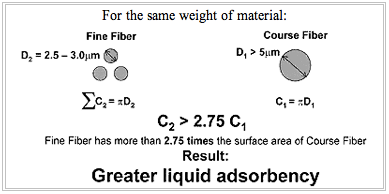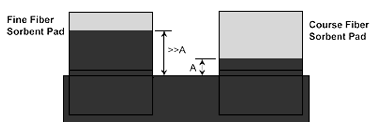Integrity Absorbents
- Rolls & Pads
- Socks & Pillows
- Booms
- Drain Protectors
- Catch Basin Inserts
- Spill Kits
- Bulk Absorbents
- Rugs & Matting
- Other Products
Understanding Absorbents
Power Poly Sorbents – Manufactured with Fine Fibre MPB
How Sorbents Work
Adsorbents
- liquid "adheres" to the surface of and between the fibers
- Polypropylene meltblown fabrics
Absorbents
- liquid penetrates the fiber and is retained both in between and inside the fibers
- Pulp based fabrics
Premium Fine Fiber Sorbents
Smaller fibers increase void space
- Increase liquid holding capacity
- Promotes greater liquid rentention
Multiple layer sorbents hold together better
- Easier clean-up / less lint
- Increases horizontal wicking to fully utilize the full pad
Fine Fiber vs. Course Fiber
Course Fiber Microstructure
- Lose fiber struture
- Widely variable fiber size
Fine Fiber Microstructure
- Greater fiber density
- More uniform capillary structure
Oil / Liquid Holding Capacity
Meltblown Sorbents
- Liquid is retained between fibers - not absorbed inside the fibers
Function of total surface area of fibers

Vertical Wicking
Smaller capillary structure draws liquid to along fiber axis for better liquid distribution and retention
- Spills spread to more of the pad

Multi-bank vs. Single Bank
Superior Strength
- Phone books vs. single sheet
Multi-bank material distributes the liquid horizontally better than single bank material
- Uses more of the pad
- Keeps the floor cleaner
- Retains liquid better
- More effective on spills

Durable vs. Linty surface
Why durable surface meltblown is better:
- Easy clean-up
- Neat & clean look
- Resists falling apart better
- Holds together better when wet
Premium Fine Fiber Sorbents
Superior Product Design
- Fine Fiber promotes better liquid dispersion
- Smaller capillary structure retains liquid better
- Multi-bank construction improves horizontal wicking while providing superior tear strength
- Durable surface makes clean-up of spills easy with less lint left behind
Results in a cleaner floor after use!